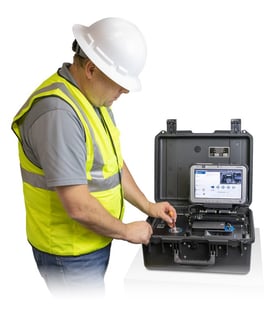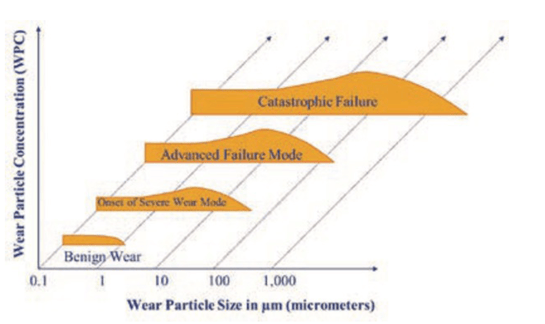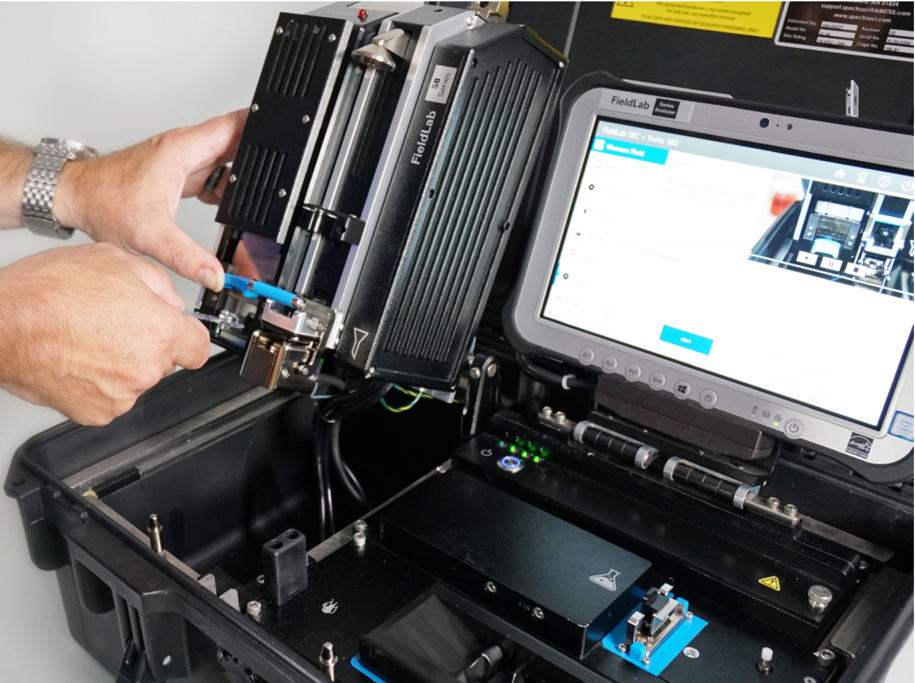Introduction
Downtime for critical equipment is costly in terms of dollar expense, productivity and human lives. Oil analysis is one of the most important and reliable techniques to keep these assets up and running.
 When deploying field solutions, careful consideration must be given to turnaround time, technique, and data integrity. The FieldLab Commercial series on-site oil analysis system provides fast results with the data integrity of a commercial oil analysis lab. The FieldLab is a rugged, portable expeditionary fluid analysis system that gives operators in the field the ability to perform comprehensive, mobile lubricant sampling. The battery-powered device enables complete lubricant assessment for condition monitoring and rapid results that permit informed maintenance decisions. It takes only 12ml of oil to perform a comprehensive oil analysis and no chemicals or solvents are needed for sample preparation or cleaning. The complete analysis, with all four tests, only takes about 5 – 7 minutes, depending on oil viscosity.
When deploying field solutions, careful consideration must be given to turnaround time, technique, and data integrity. The FieldLab Commercial series on-site oil analysis system provides fast results with the data integrity of a commercial oil analysis lab. The FieldLab is a rugged, portable expeditionary fluid analysis system that gives operators in the field the ability to perform comprehensive, mobile lubricant sampling. The battery-powered device enables complete lubricant assessment for condition monitoring and rapid results that permit informed maintenance decisions. It takes only 12ml of oil to perform a comprehensive oil analysis and no chemicals or solvents are needed for sample preparation or cleaning. The complete analysis, with all four tests, only takes about 5 – 7 minutes, depending on oil viscosity.
When deciding which technique is right for your application, it is best to understand what measurement techniques currently exist and how they are used throughout various industries. This paper compares existing analytical techniques for quantifying wear conditions and introduces the new techniques used in the FieldLab.
Existing Machine Failure Measurement Techniques
There are several machine failure measurement techniques that are currently used by on-site and third-party oil analysis laboratories. These techniques support varying industry sectors that include manufacturing, pharmaceutical, pulp and paper, mining, food and beverage, alternative energy and many others.

Particle Count
Particle count can help determine the severity of a wear situation by trending the transition from small to large particles. Particle count is performed using one of the following techniques: optical particle counting using laser light blockage, direct imaging, or pore blockage. All three of these techniques are used by oil analysis laboratories; although, the laser light is typically the more common method. A count of particles/ml for sizes >4micron, >6micron, and >14micron, is given along with an ISO Code reported per ISO 4406.
Particle count techniques include:
Optical particle counting using Laser light blocking is the most common technique used by labs. A laser light source passes through a sample. The light is partially blocked by particles so less light reaches the photodetector array, resulting in a change in voltage proportional to the area of the particles. It is important to note that oil sample with significant amounts of water and/or air bubbles, will need extra sample preparation to remove the bubbles. If not, it will skew the results and significantly increase the ISO Code. Samples with excess amounts of varnish also have the potential to spike particle count results.
Direct imaging particle counters use a pulsed laser diode and ccd photo chip. The laser illuminates the sample, and an optical lens magnifies the laser light. A camera captures the images of the sample and stores them in memory. An ISO particle count is reported and additionally the images can be analyzed by the camera for size and shape.
Pore blockage particle counters use a mesh screen to count the oil particles. They either use a constant pressure or constant flow methodology and the particles accumulate on the mesh screen. The particle count measurement is then extrapolated to report an ISO Code.
Atomic Emission Spectroscopy
Elemental identification of wear particles has traditionally been performed using atomic emission spectroscopy by either Rotating Disc Electrode (RDE) or Inductively Coupled Plasma (ICP) technologies. Both of these techniques are limited when it comes to identifying large particles. As a result, complementary techniques like acid digestion by ICP have been developed to help increase the large particle detection capability of atomic emission. Most consider these two methodologies the backbone of any oil analysis program; therefore, the inclusion of elemental analysis in any new techniques for wear particle analysis is critical.
X-ray Fluorescence (XRF)
XRF is a common technique that quantifies individual chemical elements in used oil samples. Samples are typically analyzed by taking an x-ray of a small oil sample (1-2 ml) in a cup. Similar to atomic emission techniques, the large particles associated with abnormal failure modes are not suited to this analysis technique using a cup because the focused XRF beam spot does not statistically represent the large particle distribution in only 1-2ml of oil. These results correlate well with RDE and ICP; however, the overall elemental signal is much lower. Again, this is expected based on the small XRF beam spot compared to the overall oil volume being examined. Interference from small sub-micron carbonaceous soot particles also creates issues for heavily sooted diesel engine oil samples using this technique. These types of samples require some form of baseline calibration to compensate for the soot interference.
Better sensitivity for large wear particles can be achieved by focusing the beam onto the particulate itself. This is essentially what occurs when you examine particles from magnetic chip detectors using a piece of sticky tape. RAF early failure detection centers (EFDCs) in the United Kingdom extensively use this technique.
Ferrography and Filter Patch Analysis
Microscopy is a powerful technique for identifying root causes of wear mode and mechanism failures. More advanced ferrography techniques for substrate preparation also identify ferrous from non-ferrous metals and crystalline from non-crystalline materials. Ferrogram analysis is an in depth and conclusive test since it uses heat treatment to identify different types of steel along with particle color, surface, morphology and use of polarized light. The more advanced substrate preparation, such as using a ferrogram maker, differs from straight filter patch analysis in this regard. The biggest downside to performing ferrography is that it is time consuming and requires an expert to perform the analysis.
This skill demands many years of analyzing multiple ferrograms to become skilled in the art. Microscopy techniques need to be coupled with other quicker screening techniques for them to be successful. It is not feasible to run a routine sample history using microscopy alone.
SEM EDX
The SEM EDX technique is used for visually examining particles at very high magnifications and performing spot elemental analysis on the particle using an EDX device.
The depth of field is much larger on an SEM compared to conventional metallurgical microscopes. This depth of field enhancement means the complete particle can remain in focus at high magnifications and you can achieve greater detail. Like standard wear particle analysis, using an optical microscope SEM EDX is not suitable for routine sample analysis. The instruments are expensive, and the technique involves some sample preparation, such as applying a conductive coating to the sample to help increase resolution. However, if identification of the root cause of the problem is required or further corroboration is needed, we recommend a complete Ferrography analysis.

FieldLab
A New Technique – Filtration Particle Quantification Combined with EDXRF
Understanding all the existing methodologies, allows for a better understanding of how and why the FPQ with EDXRF was developed. As defined in ASTM D8127: Standard Test Method for Coupled Particulate and Elemental Analysis using X-ray Fluorescence (XRF) for In-Service Lubricants, the FieldLab Commercial is a unique system design where machine failure and root cause analysis is interpreted by using a two step process combining a modified pore blockage technique with an XRF Analyzer. This encompasses the FPQ and XRF device in the overall oil monitor system. The filter is inserted into the XRF. This quick process can screen out samples with high particle counts and perform a complete 16 element XRF analysis on the resultant sample filter.
Combined Particle Quantifier (FPQ) and XRF Device
The modified pore blockage technique has been termed “Filtration Particle Quantification” or FPQ. The FPQ uses constant flow by driving a 12ml oil sample using a syringe through a polycarbonate filter with ~ 30,000 4um diameter holes. The resultant pressure drop across the filter, measured with reference to atmospheric pressure is used to quantify particles >4um up to ~1million particles/ml. This is achieved primarily by using a modified filter design compared to a conventional pore blockage instrument. This new patented dual dynamic design allows a much greater particle count range (x50) beyond the point where particle swapping and saturation occurs (See Illustration)

Once the analysis is complete, the filter passes from the FPQ to the XRF device. The FPQ and XRF are closely linked in terms of calibration because of the particle swapping phenomenon. The FPQ and XRF instruments use a series of unique rules and calibrations to ensure accurate elemental quantification of particles up to 1 million particles/ml. This technique combined with the patented filter overcomes the problem with the oil cup analysis which XRF devices typically use. This unique filter design is able to corral the particles into a small area on the filter so the focused X-ray beam can concentrate its energy on those particles. The instrument uses an X-ray tube with Rhodium target, max voltage 50kV with 122eV FHM resolution at 5.9keV to detect up to 16 elements with sub-ppm limits of detection.
Summary
The FPQ, with its patented dual dynamic filtration system, handles a wide range of lubricant applications with varying wear levels. The particle count using the FPQ filter correlates with existing direct imaging particle counting. The subsequent elemental concentration from the FPQ filter using XRF analysis correlates well with ICP differential acid digestion. The combined particle count and elemental concentration identifies changing wear rates and isolates potential root causes of problems in lube systems. Particle count and elemental concentration provides the real elemental break down of particles captured and quantified on the filter. This methodology eliminates many of the problems associated with other techniques such as particle size detection and the impervious nature of many used oils found in heavy duty industrial applications.

STLE member Lisa Williams is a results-focused solution provider working in reliability engineering and tribology for the past 15 years. Specializing in lubricant analysis, she currently serves as the technical training manager at Ametek Spectro Scientific.


